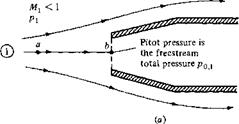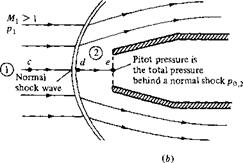Subsonic Compressible Flow
Consider a Pitot tube in a subsonic, compressible flow, as sketched in Figure 8.10a. As usual, the mouth of the Pitot tube (point b) is a stagnation region. Hence, a fluid element moving along streamline ab is brought to rest isentropically at point b. In turn, the pressure sensed at point b is the total pressure of the freestream, p„ i. This is the Pitot pressure read at the end of the tube. If, in addition, we know the freestream static pressure p, then the Mach number in region 1 can be obtained from Equation (8.42),
or solving for Mf,
Clearly, from Equation (8.74), the Pitot pressure p,,., and the static pressure p, allow the direct calculation of Mach number.
The flow velocity can be obtained from Equation (8.74) by recalling that M = u/a. Hence,
From Equation (8.75), we see that, unlike incompressible flow, a knowledge of pop and p is not sufficient to obtain и,; we also need the freestream speed of sound, a.
8.7.8 Supersonic Flow
Consider a Pitot tube in a supersonic freestream, as sketched in Figure 8.106. As usual, the mouth of the Pitot tube (point e) is a stagnation region. Hence, a fluid element moving along streamline cde is brought to rest at point e. However, because the freestream is supersonic and the Pitot tube presents an obstruction to the flow,
![]()
|
|
|
there is a strong bow shock wave in front of the tube, much like the picture shown at the left of Figure 8.1 for supersonic flow over a blunt body. Hence, streamline cde crosses the normal portion of the bow shock. A fluid element moving along streamline cde will first be decelerated nonisentropically to a subsonic velocity at point d just behind the shock. Then it is isentropically compressed to zero velocity at point e. As a result, the pressure at point e is not the total pressure of the freestream but rather the total pressure behind a normal shock wave, po,2- This is the Pitot pressure read at the end of the tube. Keep in mind that because of the entropy increase across the shock, there is a loss in total pressure across the shock, po,2 < Po, і ■ However, knowing po,2 and the freestream static pressure p is still sufficient to calculate the freestream Mach number Mb as follows:
![]() P0,2 __ P0,2 Pi Pi Pi Pi
P0,2 __ P0,2 Pi Pi Pi Pi
Here, p^ijpi is the ratio of total pressure to static pressure in region 2 immediately behind the normal shock, and рг/Pi is the static pressure ratio across the shock. From
Also, from Equation (8.65),
Substituting Equation (8.78) into (8.77), and substituting the result as well as Equation (8.79) into Equation (8.76), we obtain, after some algebraic simplification (see Problem 8.14),
Equation (8.80) is called the Rayleigh Pitot tube formula. It relates the Pitot pressure po,2 and the freestream static pressure p to the freestream Mach number M. Equation (8.80) gives Mx as an implicit function of рол/Pi and allows the calculation of Mx fromaknown рол/Рі – For convenience in making calculations, the ratio Рол/Рі is tabulated versus Mi in Appendix B.
![]() A Pitot tube is inserted into an airflow where the static pressure is 1 atm. Calculate the flow Mach number when the Pitot tube measures (a) 1.276 atm, (b) 2.714 atm, (c) 12.06 atm.
A Pitot tube is inserted into an airflow where the static pressure is 1 atm. Calculate the flow Mach number when the Pitot tube measures (a) 1.276 atm, (b) 2.714 atm, (c) 12.06 atm.
Solution
First, we must assess whether the flow is subsonic or supersonic. At Mach 1, the Pitot tube would measure p0 = p/0.528 = 1.893/?. Hence, when p0 < 1.893 atm, the flow is subsonic, and when p0 > 1.893 atm, the flow is supersonic.
(a)
Pitot tube measurement = 1.276 atm. The flow is subsonic. Hence, the Pitot tube is directly sensing the total pressure of the flow. From Appendix A, for р0/p = 1.276,
(b) Pitot tube measurement = 2.714 atm. The flow is supersonic. Hence, the Pitot tube is sensing the total pressure behind a normal shock wave. From Appendix B, for po,2/Pi = 2.714,
![]()
|
(c)
Pitot tube measurement = 12.06 atm. The flow is supersonic. From Appendix B, for Ро. г/Рі = 12.06,
Example 8.8 I Consider a hypersonic missile flying at Mach 8 at an altitude of 20,000 ft, where the pressure is 973.3 lb/ft2. The nose of the missle is blunt and is shaped like that shown at the left of Figure 8.1. Calculate the pressure at the stagnation point on the nose.
Solution
Examining the blunt body shown in Figure 8.1, the streamline that impinges at the stagnation point has traversed the normal portion of the bow shock wave. By definition, V = 0 at the stagnation point. Since the flow is isentropic between the shock and the body, the pressure at the stagnation point on the body is the total pressure behind a normal shock with an upstream Mach number of 8. Let us denote the pressure at the stagnation point by ps. Since p0 2 is the total pressure behind the normal shock, then ps = p02. From Appendix B, for Mach 8, Ро. г/Рі = 82.87. Hence,
![]() Ps = Po,2 = (Pi) = 82.87(973.3) =
Ps = Po,2 = (Pi) = 82.87(973.3) =
Since 1 atm = 2116 lb/ft2,
![]() _ 8.07 x 104
_ 8.07 x 104
Ps ~ 2П6 _
Note that the pressure at the nose of the missile is quite high—38.1 atm. This is typical of hypersonic flight at low altitude.
Check on the calculation This problem can also be solved by first calculating the upstream total pressure from Appendix A, and then using the total pressure ratio across the normal shock from Appendix B. From Appendix A for Mach 8, Po, i/Pi = 0.9763 x 10-4. Hence,
p0,i = (y1) Pt = (0.9763 x 104)973.3 = 9.502 x 106
From Appendix В for Mach 8, р0,г/Po. i = 8.8488 x 10 2. Hence,
![]() p, = рог = ( — ) Po і = (0.8488 x 10~z)(9.502 x 106) =
p, = рог = ( — ) Po і = (0.8488 x 10~z)(9.502 x 106) =
’ Po. i/ ’
This is the same result as obtained earlier.













